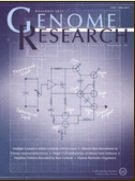A new publication from scientists at the University of California, San Diego, demonstrates the use of Single Molecule, Real-Time (SMRT®) Sequencing to identify structural variation (SV) breakpoints in cancer.
“Amplification and thrifty single molecule sequencing of recurrent somatic structural variations” was published in Genome Research and comes from authors Anand Patel, Richard Schwab, Yu-Tsueng Liu, and Vineet Bafna.
In the paper, the scientists report development of a new method — Amplification of Breakpoints, or AmBre — to detect important structural variant breakpoints. AmBre relies on a PCR-based approach for amplification of the structural variant, followed by sequencing on the PacBio® platform to resolve the exact breakpoints. The method was tested on several cancer cell lines that contained such extensive genomic rearrangements, including deletions of tumor suppressor genes.
The authors note that breakpoints of structural variation are far more individualized than the structural variants themselves; they posit that these breakpoints have “utility as patient specific tumor biomarkers.” A reliable way to detect breakpoints, then, could have clinical relevance for cancer patients. In addition, the method can also be used to validate structural variants found with other sequencing (exome or genome) or microarray-based methods.
The team used SMRT Sequencing of pooled amplicons in a single SMRT Cell as well as a custom-built algorithm to sort reads by breakpoint and then call a consensus sequence representing a particular structural variant. The AmBre approach was validated on cancer cell lines including A549, CEM, and Detroit562 by successfully identifying CDKN2A deletion breakpoints. It was then applied (and confirmed by Sanger sequencing) to cell lines MCF7 and T98G for which the breakpoints had not been identified in spite of previous efforts, including whole genome sequencing of the MCF7 cell line. Interestingly, the SNP-array estimate for the MCF7 breakpoint is 15 kb away from the AmBre detected breakpoint, likely due to repeat elements close to the upstream MCF7 breakpoint. The authors note that “Repetitive sequences are known to confound structural variation analysis and possibly explains why previous genome sequencing studies of MCF7, have not annotated the CDKN2A deletion breakpoints”.
The authors also show that AmBre captures more complex rearrangements, like interchromosomal translocations, by resolving the RUNX1-RUNX1T1 gene fusion which forms from a translocation between chromosome 21 and chromosome 8. In addition, “the AmBre assay, unlike other methods, can target DNA with a SV in the context of high background of germline DNA”, a feature “important for sensitive detection of tumor DNA and establishing a patient specific tumor DNA marker for monitoring tumor burden.” They demonstrate successful targeting of SVs by AmBre in heterogeneous samples where tumor DNA was present in as little as 1:1000 of the sample.
The paper was also reported on by In Sequence in an article entitled UCSD Team Develops PacBio Sequencing Method to ID Structural Variant Breakpoints (free access).
